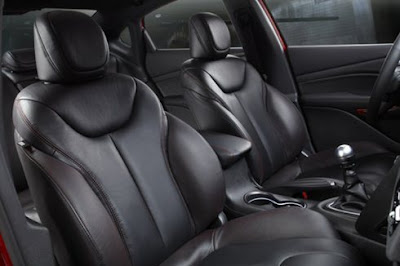It's all well and good to build sweet-looking Chargers and Challengers, but if you want to sell cars to mainstream Americans, you need a credible entry in the compact car segment. And it looks as if Dodge may finally have one in the 2013 Dart.
Dodge's new front-wheel-drive sedan is essentially an enlarged version of the Alfa Romeo Giulietta we drove last year. Its 106.4-inch wheelbase is about the same as the Hyundai Elantra's, but it's longer (183.9 inches) and wider (72 inches) than the Elantra and other likely rivals such as the Chevrolet Cruze, Ford Focus, Honda Civic and Mazda 3. Legroom in the Dart looks to be competitive but not class-leading, but it has more front shoulder room and hiproom than its rivals.
Looking at the Dodge Dart, it's obvious that style is going to be a huge part of its appeal. Company designers have applied styling elements from the rear-drive cars, including Charger-esque LED taillights, but nothing feels forced or cartoonish. Moreover, there's good reason to think the Dart will actually be pretty agreeable to drive.
The Dart starts production in the second quarter of 2012, initially with two engines: the so-called “Tigershark” 2.0-liter naturally aspirated four-cylinder and a 160-hp, 1.4-liter turbocharged and intercooled four similar to the one found in the Fiat 500 Abarth. Both make 160 hp, but they have vastly different torque ratings; the 2.0 whips up just 145 lb-ft, while the 1.4 turbo will offer 184. A few months after launch, a 184-hp, 171 lb-ft 2.4-liter “Tigershark” four will come online. There’s no word yet on a hopped-up SRT4 model (or even a Swinger variant for that matter).
Both the 1.4- and the 2.4-liter powerplants employ MultiAir technology, although the latter features the slightly revised MultiAir 2 system. MultiAir 2 is said to offer more efficient exhaust-gas recirculation by more precisely controlling the start and end of the valve events and extending the opening on the intake cycle. Darts equipped with the 1.4-liter turbo will have just one intercooler, as opposed to the two tinier units found in the Fiat 500 Abarth.
The 2.0 and the 2.4 Tigersharks are based on the previous units found in Chrysler’s powertrain portfolio. In an effort to keep the passenger compartment free of extraneous engine noise—a massive problem with the Caliber—both have had their cylinder heads rotated 180 degrees, thus putting the noisy exhaust bits toward the nose of the vehicle and the less-raucous intake mechanicals toward the occupants.
The all-aluminum 2.0-liter is standard and the iron-block/aluminum-head 1.4-liter turbo is optional on the Dart SE, SXT, Rallye, and Limited models. The late-arriving, all-aluminum 2.4-liter will be exclusive to the R/T. All are to be built at the GEMA engine plant in Dundee, Michigan. Fuel-economy ratings have not been released.
The Interior
The Engine





















0 komentar:
Post a Comment